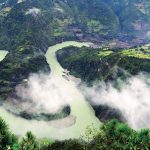Will hydropower turn the tide on the Salween River?

Both history and future development plans point to risks for the Salween River and its eco-systems and communities. Over-development, lack of public consultation and the appetite for energy threaten Asia’s last free flowing, international river. It is among the most visited, most photographed and most widely known natural wonder: the Grand Canyon of the Colorado River in the United States. But nearly 180 degrees around the globe sits the Grand Canyon of the East: deeper, longer and virtually unknown. These gorges were carved by China’s Nu River (Salween River within Myanmar and Thailand) and its kinship with the storied Colorado extends well beyond their geologic superlatives. Like the native American Indian tribes of the Grand Canyon, the Nu is shared by a vast array of ethnic minorities unique within Asia. Both canyons are World Heritage Sites. Both support unique assemblages of endemic species found nowhere else on earth. But the question now is, will efforts to sustainably steward this, Asia’s last free flowing, international river, parallel those launched a half-century ago and half a world away? Those efforts not only protected the Grand Canyon, but ushered in a new era of environmental protection. However, even with active community engagement, the river was still extensively dammed and concerns still remain over damages to environmentally important sites.

